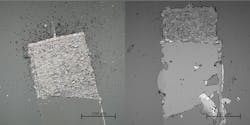OPTICAL COATINGS: AR coating for sapphire has high scratch resistance
Sapphire is an exceptional optical material: in addition to its extreme hardness, it transmits light of wavelengths between 0.2 and 5.5 μm, is highly transparent for all but the edges of this range, and conducts heat well. It does have drawbacks, however. First, it is a birefringent crystalline material, and as a result is used only in applications that tolerate this property, such as windows, domes, and certain lenses. Second, it has a high refractive index and thus usually requires an antireflection (AR) coating.
Combining sapphire with conventional AR coatings, which are relatively soft, might not make sense for some applications that demand the strength for which sapphire is often chosen. In response to this problem, a group at the Fraunhofer-Institute for Applied Optics and Precision Engineering (Jena, Germany) has tested a variety of hard coatings based on a design normally used in hard AR coatings for plastic eyeglass lenses.1 Varying the materials as well as the design details, the researchers came up with a hafnium-containing coating that has an improved resistance to scratching.
Low effective index
The eyeglass-coating design consists of a series of 0.75λ multilayer stacks, each consisting of a very narrow high-index layer sandwiched by two low-index layers; the sandwich has the property of lowering the effective refractive index to a level that is actually lower than that of the low-index material. The multilayer stacks are topped with a full-wave stack containing a thin and a thicker layer of high-index material amid layers of low-index material.
Several versions of this coating were tested. Silicon dioxide (SiO2) served as the low-index material in all of them, while the high-index material was one of the following oxides: hafnium (HfO2), titanium (TiO2), yttrium (Y2O3), or zirconium (ZrO2). The coatings were fabricated using plasma-ion-assisted deposition and were densified during growth using argon-ion bombardment.
Scratch resistance was characterized using a laterally oscillating diamond needle that was translated along the coating surface while gradually being pressed into it, which progressively decreases the oscillation range of the needle. At a load called the critical load, the oscillation suddenly decreases and the coating is simultaneously damaged. Other tests with a nanoindenter determined the stiffness (Young's modulus) and yield strength of the various coatings.
The HfO2-based coating had the highest critical load (391 mN) and was chosen for further testing. Several different thicknesses ranging from 270 nm to just over 2000 nm were fabricated; tests showed that a coating of intermediate thickness (472 nm) had the highest critical load of 419 mN. While the thinner coatings failed from abrasion, the thicker coatings failed by delamination (see figure).
The explanation for the higher strength of the HfO2 coating relative to the others lies in the nature of the materials. While the other high-index oxides and the low-index SiO2 remained amorphous upon deposition, the HfO2 had a crystalline structure (as revealed by x-ray diffraction measurements) and much higher yield strength.
Optical performance
A HfO2 coating similar in thickness (452 nm) to the best mechanically tested coating shows excellent AR characteristics. While uncoated sapphire has a reflectivity of 14% to 15% across the visible spectrum, the HfO2 coating reflected less than 1.3% throughout a spectral range from 440 to 710 nm. This coating could be useful for many purposes, ranging from sapphire optics for outdoor imaging systems to high-grade watch glasses.
REFERENCE
1. C. Gödecker et al., Appl. Opt., 50, 9, C255; doi:10.1364/AO.50.00C253 (2011).
About the Author
John Wallace
Senior Technical Editor (1998-2022)
John Wallace was with Laser Focus World for nearly 25 years, retiring in late June 2022. He obtained a bachelor's degree in mechanical engineering and physics at Rutgers University and a master's in optical engineering at the University of Rochester. Before becoming an editor, John worked as an engineer at RCA, Exxon, Eastman Kodak, and GCA Corporation.

